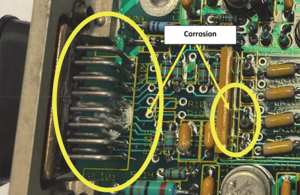AAIB Report: BAe ATP (SE-LPS), Autopilot failed to disengage prior to landing, Ronaldsway Airport, Isle of Man.
During a flight to Ronaldsway Airport on the Isle of Man, the crew of a BAe ATP (SE-LPS) reported that there was no audio tone to confirm the disengagement of the autopilot. Both pilots reported unusual resistance in the flying controls, which suggested that the autopilot had not disengaged.

Corrosion deposits inside the audio warning unit
During a flight to Ronaldsway Airport on the Isle of Man, as the aircraft approached the minimum descent altitude, the autopilot would not disengage. There was no audio tone to indicate the disengagement and the co-pilot (pilot flying) felt there was resistance in the flying controls. Despite this, the cockpit indications showed that the autopilot had disengaged. Subsequently the synchronisation (SYN) button was pressed, which released the controls and the flight landed safely. Both pilots were unharmed.
A definite cause for the autopilot not disengaging could not be found but the manufacturer responsible for the design of the autopilot identified a possible scenario where the autopilot servomotors could remain engaged after the autopilot disengaged. This would result in higher-than-normal forces at the cockpit controls. Audio anomalies during the flight were probably caused by corrosion in the audio warning unit because of moisture ingress through the DV windows.
As a result of this investigation safety action was taken by the CAA to consider additional testing of the autopilot system as part of the continued airworthiness programme for the ATP. The operator took safety action to reconfigure their fleet so that either pilot could override either autopilot via the SYN button on their respective control wheel. The operator also initiated remedial action to try and prevent water ingress into the cockpit.
In addition, two Safety Recommendations have been made to the CAA regarding the use of magnetic tape recorders.
Media enquiries call: 01932 440015 or 07814 812293